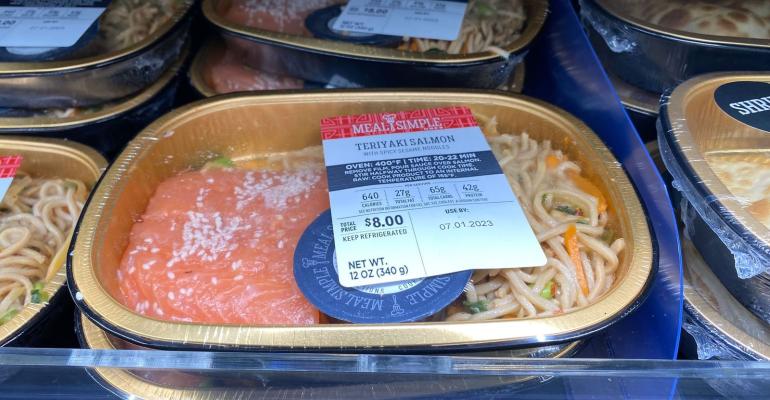Despite a slowdown in the inflation rate, overall seafood aisle sales activity remains off course.
Though the average fresh seafood price of $9.32 per pound is up just 0.1% over last year, sector volume and dollar sales still declined 3.0% and 2.9%, respectively, for the 52 weeks ending Aug. 13, reports Circana, a Chicago-based market research firm.
Among species, salmon and shrimp, the first and third most popular fresh seafood options, had volume sales declines of 1.4% and 16.7%, respectively, along with higher-than-average price per pound increases of 3.7% and 5.2%.
Fresh crab, second in fresh seafood sales, had a 23.7% volume increase, which is largely resulting from a 16.8% price decrease, analyst said.
Shopper concerns about higher prices throughout the economy is contributing to sales declines in most seafood categories, said Anne-Marie Roerink, president of 210 Analytics LLC, a Chicago-based market research and marketing strategies firm and preparer of the Seafood at Retail report.
“Even though seafood has seen very little inflation overall, there hasn’t been the demand uptick one would normally see in response,” she said. “Fewer people are buying fresh seafood, and those who are buying it are doing so less often.”
To spur activity, retailers should implement cost-saving measures, including promotions that target the species with sales decreases and those that are more affordable, said Chuck Anderson, vice president and partner with Certified Quality Foods, a Dallas-based analyzer of seafood quality, and the former vice president of seafood procurement for Quincy, Mass.-based Ahold USA. He is also the former category manager for seafood at San Antonio-based H-E-B.
“Promoting shrimp and crab can help offset lower sales in higher-priced fresh fish products,” he said, adding that shrimp promotions should go beyond the usual best-selling items. “Why not sell farmed white, brown, pink, wild, white, and red shrimp, and each of these varieties in raw shell-off and cooked shell-off forms?” Anderson said. “The easier the product is to handle and prepare, the larger the customer base that will buy these products. Usually, the 10th best-selling shrimp SKU is more profitable than the third best-selling white fish SKU.”
Additionally, retailers can attract more convenience-oriented shoppers by promoting value-added products, he said. “A 6-ounce ready-to-cook cod or salmon portion can sell for under $10 with all-day sales potential,” Anderson said.
Educating shoppers on the different seafood selections in the case is also vital for generating greater activity, said Eric Le Blanc, senior vice president of marketing at Category Partners LLC, an Idaho Falls, Idaho-based fresh food industry research and consulting firm.
“The shopper has deep information needs at the seafood counter, and virtually none of the needs are being met,” he said. “Whether it is delivered via signage, QR codes, screens, or kiosks, it is urgent to provide more information at the point of purchase.”
Such data can indicate if the seafood is wild-caught or farm-raised; provide the geographic origin of the product; recommend recipes and other preparation methods; and suggest how to make the post-meal clean-up easier, Le Blanc said.
“The purchase decision is going to be driven by inspiration and confidence,” he said. “Give a good idea and make the shopper confident that they can execute it.”
Extensive interactions and information sharing is especially vital for spurring activity from the traditional non-seafood buyer, said Melissa Rodriguez, Circana principal. That includes having knowledgeable staffers who can answer all shopper questions and situating ample signage in the seafood department, she said. “Any signage is good signage as it helps keep seafood top of mind,” Rodriguez said.
Merchandising a multitude of fresh seafood options at different price points is also effective for generating sales from different shopper segments, she said, as well as leveraging the growing popularity of sushi to interest shoppers in other seafood varieties. Retailers, for instance, can situate signage next to sushi displays in the supermarket deli that urges shoppers to investigate additional species in the seafood department, Rodriguez said.
Among the already active seafood merchandisers is Modesto, Calif.-based The Save Mart Companies, which is using a combination of price, variety, and information to enhance activity, said Patrick Pottgieser, director of seafood merchandising.
The operator is training associates on product knowledge and customer service “to help educate and instill confidence for shoppers that will increase frequency of purchases,” he said. The company also is seeking “out of the box offerings to build on the ‘treasure-hunt’ shopping experience and create those ‘wow’ merchandising experiences when customers visit the department,” Pottgieser said.
The Save Mart Companies, which operates approximately 200 stores under the Save Mart, Lucky California, and FoodMaxx banners in California and Northern Nevada, uses market data and researches the products available at competitors’ stores to determine the most appropriate seafood to offer in each location, Pottgieser said.
He said that a major challenge is keeping pace with the continual shifting of customer buying habits because of economic conditions. “One of the best ways to meet the challenges is in providing product offerings with an equal balance of quality and value,” Pottgieser said.
That can include merchandising seafood that is priced by the portion size, such as ready-to-cook salmon, and offering meal options that combine seafood with side dishes, Anderson said.
Yet, Anderson warned that “creating and growing a significant self-service ready-to-cook and ready-to-eat seafood program takes dedication and time, along with having proper self-service cases, packaging, on-package instructions, and preferably in-store sampling to get items accepted one at a time.”
It also requires a commitment by operators to provide the necessary resources to hire, train, and retain seafood talent, he said. “This means competitive starting salaries for front-line employees and especially for the seafood manager,” Anderson said. “Seafood managers and staff need more training than other departments.”





